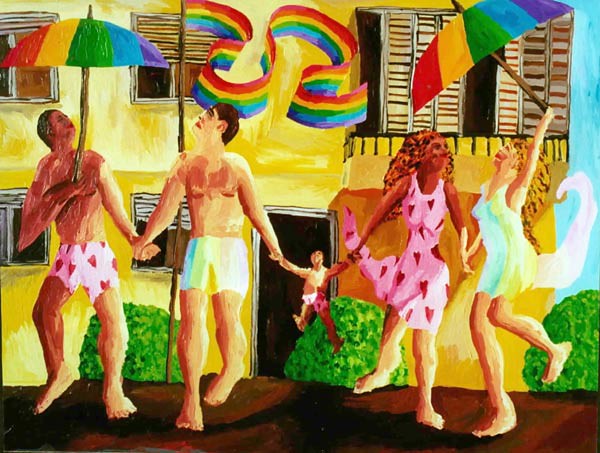At the time of writing this, it had been a few months since it came out that actor John Travolta may have had sex with men.
Whatever the facts of the case, the blogosphere and my sex therapist circles were aflutter with speculation. What did this mean? Was John Travolta gay? Does sex with men necessarily mean gay?
The fascinating Good Men Project post “Mostly Straight Most of the Time” talks about men who identify as “mostly straight,” including men who feel politically or personally limited by the heterosexual male role, men who find other men attractive but primarily enjoy sex with women, and men who have romantic feelings or enjoy cuddling or going “beyond platonic” with other men, but not having sex. It also talks about men who have sex with other men, but still identify as “mostly straight.”
For example, the article quotes a man named Dillon who explains that “he resides in the ‘Sexual Netherlands,’ a place that exists between heterosexuality and bisexuality.”
So what is going on with these men? Are they gay, straight or bisexual? My answer to that question is that it is the wrong question. Rather than trying to squeeze people into existing labels, perhaps we should be making new labels. Can you be sexually gay and romantically straight, or as some of my colleagues described it, “homo-sexual and hetero-emotional? ” Of course! You can be anything. That is what we keep missing. No matter how many categories we make, people will keep inhabiting “the Netherlands in between.”
I personally feel somewhat more sexually attracted to men than women, but still sexually attracted to women… perhaps in a different way? Affectionally or romantically, I think I might feel slightly more pull toward women than men, but still feel romantic toward men. Then again, there are men who are more like women and women who are more like men, and transgender folk, and genderqueer folk, and people who are cisgender, but don’t follow traditional gender roles. I could be sexually or affectionally drawn to any of them!
I tend to be most attracted to people who exhibit a combination of traditionally male and traditionally female traits, but still identify with a clear male or female gender identity, though in a subtle way. What does that make me? It makes me hard to label. I love the term pansexual because it separates gender from sexual orientation, allowing attraction to be more about other things. It also rejects the false dichotomy between sexual/romantic and platonic relationships. To me, pansexual takes into account the complexity of sexual and affectional orientation.
The currently accepted gay/straight dichotomy with bisexual in the middle presents the following limitations:
1. Gender as a concept is problematic.
In order to label your orientation based on gender, you have to be able to label everyone as a gender. Tricky and getting trickier!
2. Research is making it clearer and clearer that sexual orientation is fluid.
See the wonderful work of Lisa Diamond on fluidity. Sexual orientation changes over the lifespan way more than most of us realize.
3. Sexual orientation labels attempt to describe feelings and behaviors that exist along a spectrum as discrete entities with no gray area in between.
It’s as useful as calling everyone under four feet “short,” everyone between four and six feet “medium height,” and people over six feet “tall” and then asking each group to all wear the same size clothes. Of course there are people who fall in between straight and bisexual, in between bisexual and gay, etc. The “Mostly Straight, Most of the Time” piece states, “National surveys in the U.S. and Canada show that three to four percent of male teenagers, when given the choice to select a term that best describes their sexual feelings, desires, and behaviors, opt not for heterosexual, bisexual, or gay, but for ‘mostly’ or ‘predominantly’ heterosexual.”
4. Types of attraction also exist along a spectrum.
Relationships don’t fall neatly into platonic and romantic categories or sexual and non-sexual categories as easily as you would think, given our current labels. We can experience sexual feelings or sexual tension and not want to have sex. There are sensual aspects to almost all human interactions—including with our children, parents, and siblings, with close friends, bosses, or the person who delivers our mail. Sometimes the beginning of a new friendship can feel like a romance. A close friendship can include physical and emotional intimacy. Sometimes sex is just about getting off, sometimes much more. Some folks have primary and secondary romantic relationships, or more than one equally weighted relationship at a time.
I believe Kinsey had it right when he introduced the spectrum idea—that there is a spectrum between gay and straight.
What we need to add is just how many spectrums there are. It’s not just how gay or straight you are, it’s how gay or straight are you at a certain age, in a certain emotional state, with a certain person, in a sexual situation, a romantic situation, a sensual situation, when there is an emotional connection, or some combination of these. What are your romantic, sexual, sensual, emotional reactions to people with various types of gender expression? These questions can’t be answered with a simple gay or straight, or even “I’m a 6 out of 10.”
I’m not advocating we throw out the terms gay and straight. There are very important reasons to emphasize difference, even while seeking equality. Nuance is not politically expedient. Some of us are kind of like you some of the time and not like you some of the time, and you are probably more like us than you’d like to admit and we all change over time, so please allow us marriage equality.
This would make for a horrifically bad Human Rights Campaign slogan. It’s about as compelling as “Read my lips… no new taxes… unless the following 10 things happen.”
We are gay, we always want sex and romance with people of the same sex, we were born this way, we will always be this way is a much easier sell. Even some of us are right in between and like both males and females, which is a lot easier to sell than trying to explain that male and female may not even be that useful in assessing our level of interest in another person and doesn’tapply to a sizable and increasingly visible portion of the population.
For these reasons, there is a tendency among queer folk and allies to assume those who insist on identities like “mostly straight” or who operate on the “down low” are closeted and unwilling to be honest about their identities. Are there people who don’t use existing labels because they would rather shield themselves from the minority stress associated with being “out” as a sexual minority? Of course! But I believe there are also many folks (myself included) who have a sense that the gay/straight/bi categories don’t quite fit them.
So are these categories useless, then?
No, I don’t believe so. I believe many labels become stepping stones to other more nuanced ones. Without gay and straight we would never have had bisexual and transgender, and without those, we never would have come to pansexual, genderqueer, etc. How do we strike the right balance? How do we advocate for the queer community and build new notions of identity while also acknowledging that identity is complex and nuanced? And still explain that our labels are currently limited, but will keep growing?
Not easily. We are simultaneously shackled and set free by these labels. We need to be able to question and expand upon existing labels, acknowledging their limitations, without throwing them out altogether or assuming the labels themselves are the problem. We need to be able to use them and question them and make room for new types of identities all at the same time.
Enter to win the best of CBD for sexual wellness >>


 Share on bsky
Share on bsky






Read 33 comments and reply